Euler's Identity 631 words written by Nathan Lilienthal
\[e^{\pi i} + 1 = 0\]This equation is supremely beautiful and bewildering. It uses 5 very fundamental objects: \(0\), \(1\), \(\pi = 3.141\ldots\), \(e = 2.718\ldots\), and \(i = \sqrt{-1}\), along with 4 operations: \(a + b\) (addition), \(a b\) (multiplication), \(a^b\) (exponentiation), and finally \(a = b\) (equality, identity).
\[e^{\frac{\pi i}{2}} = i \\ e^{\pi i} = (e^{\frac{\pi i}{2}})^2 = i^2 = -1 \\ e^{\frac{3\pi i}{2}} = (e^{\frac{\pi i}{2}})^3 = i^3 = -i \\ e^{2\pi i} = (e^{\frac{\pi i}{2}})^4 = i^4 = 1\]Then it repeats…
\[e^{\frac{5\pi i}{2}} = (e^{\frac{\pi i}{2}})^5 = i^5 = i \\ \vdots\]If you can’t see the “whole” picture yet (can anyone?), this might help. Our cyclic circular sidekicks, \(\sin\) and \(\cos\) are here to enlighten us.
Euler’s identity is a special case of Euler’s formula, which states:
\[e^{i \theta} = \cos(\theta) + i \sin(\theta)\]Substitute \(\pi\) (or in general, \(n\pi\)) for \(\theta\) and we get back our identity.
\[\begin{align} \cos(\pi) + i \sin(\pi) = -1 + 0 =\ & e^{\pi i} = i^2 \\ & e^{\pi i} + 1 = 0 \end{align}\]Tangent on Fourier Series
TODO: This information is only a sketch, and as such is somewhat sketchy.
Plot[
sin(theta)/pi,
(3/2) sin(theta)/pi,
2 sin(theta)/pi,
(5/2) sin(theta)/pi
]
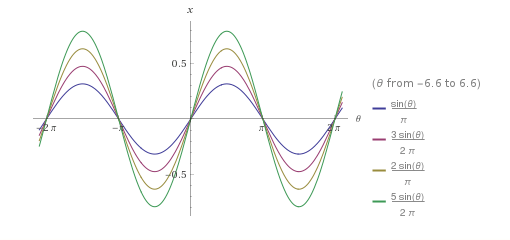
Unlike the “Euler series” we above, which is purely constructive, a square wave can be constructed with the Fourier series:
\[\sin(2 \pi \theta), \frac{1}{3} \sin(6 \pi \theta), \frac{1}{5} \sin(10 \pi \theta), ...\]Plot[
sin(2 pi theta),
(1/3) sin(6 pi theta),
(1/5) sin(10 pi theta)
]

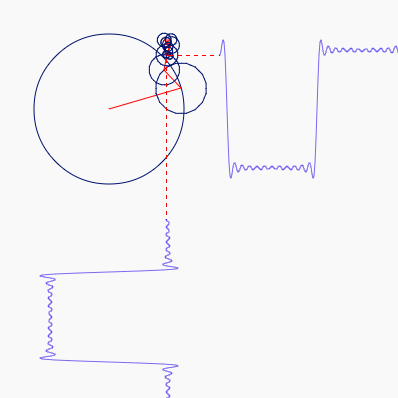
And a saw wave can be constructed by another:
\[\sin(\pi \theta), \sin(\frac{\pi \theta}{2}), \sin(\frac{\pi \theta}{4}), \ldots\]Plot[
sin(pi theta),
sin((pi theta) / 2),
sin((pi theta) / 4)
]
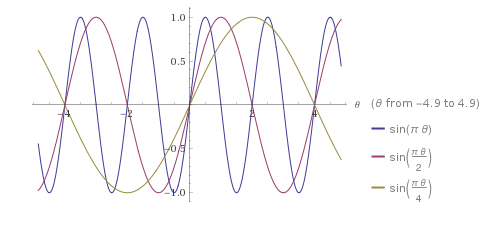
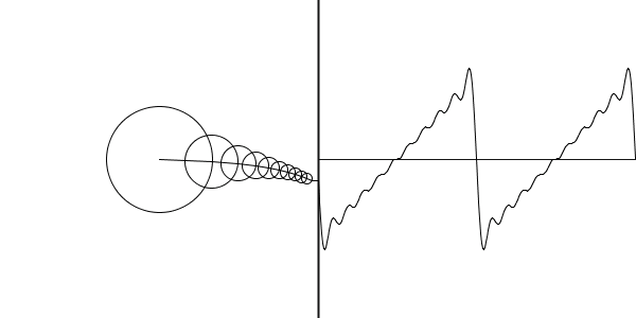
Euler’s identity can be geometrically interpreted as saying that rotating any point \(\pi\) radians around an origin of a complex plane has the same effect as reflecting the point across the origin.
Fundamentally, Euler’s Identity is a root of unity, meaning that it is a solution for \(z\) in the equation \(z^n = 1\).
\[z = e^{2\pi i} = i^4\]This is the definition for a more general identity which states that the \(n\)th roots of unity, for \(n \gt 1\), add up to \(0\).
\[\sum_{k=0}^{n-1} e^{2\pi i\frac{k}{n}} = 0\]Euler’s identity is the \(n = 2\) case of this equation.
\[e^0 + e^{\pi i} = e^{\pi i} + 1 = 0\]A fun fact from a friend.
My friend Ryan showed me an interesting approximation of \(e\) which uses numbers \(1, 2, 3, 4, 5, 6, 7, 8, 9\) each once:
\[e \approx \left(1 + 9^{-4^{6 \times 7}}\right)^{3^{2^{85}}}\]This may be less surprising if we recall that \(e\) can be defined as:
\[e = \lim_{n \to \infty} \left(1 + \frac{1}{n}\right)^n\]So we have \(n \gets 3^{2^{85}} \approx \left(9^{-4^{6 \times 7}}\right)^{-1}\), which substituting in the above, gives an approximation of \(e\).
Wanna compute e in Brainfuck?
$$ \hphantom{nothing} \\ e = 2.718281828459\ldots $$
git clone https://github.com/nixpulvis/brainfuck
cd brainfuck
cargo run fixtures/e.bf
>>>>++>+>++>+>>++<+[
[>[>>[>>>>]<<<<[[>>>>+<<<<-]<<<<]>>>>>>]+<]>-
>>--[+[+++<<<<--]++>>>>--]+[>>>>]<<<<[<<+<+<]<<[
>>>>>>[[<<<<+>>>>-]>>>>]<<<<<<<<[<<<<]
>>-[<<+>>-]+<<[->>>>[-[+>>>>-]-<<-[>>>>-]++>>+[-<<<<+]+>>>>]<<<<[<<<<]]
>[-[<+>-]]+<[->>>>[-[+>>>>-]-<<<-[>>>>-]++>>>+[-<<<<+]+>>>>]<<<<[<<<<]]<<
]>>>+[>>>>]-[+<<<<--]++[<<<<]>>>+[
>-[
>>[--[++>>+>>--]-<[-[-[+++<<<<-]+>>>>-]]++>+[-<<<<+]++>>+>>]
<<[>[<-<<<]+<]>->>>
]+>[>>>>]-[+<<<<--]++<[
[>>>>]<<<<[
-[->--[<->+]++<[[>-<+]++[<<<<]+>>+>>-]++<<<<-]
>-[+[<+[<<<<]>]<+>]+<[->->>>[-]]+<<<<
]
]>[<<<<]>[
-[
-[
+++++[>++++++++<-]>-.>>>-[<<<----.<]<[<<]>>[-]>->>+[
[>>>>]+[-[->>>>+>>>>>>>>-[-[+++<<<<[-]]+>>>>-]++[<<<<]]+<<<<]>>>
]+<+<<
]>[
-[
->[--[++>>>>--]->[-[-[+++<<<<-]+>>>>-]]++<+[-<<<<+]++>>>>]
<<<<[>[<<<<]+<]>->>
]<
]>>>>[--[++>>>>--]-<--[+++>>>>--]+>+[-<<<<+]++>>>>]<<<<<[<<<<]<
]>[>+<<++<]<
]>[+>[--[++>>>>--]->--[+++>>>>--]+<+[-<<<<+]++>>>>]<<<[<<<<]]>>
]>
]
This program computes the transcendental number e, in decimal. Because this is
infinitely long, this program doesn't terminate on its own; you will have to
kill it. The fact that it doesn't output any linefeeds may also give certain
implementations trouble, including some of mine.
(c) 2016 Daniel B. Cristofani
http://brainfuck.org/
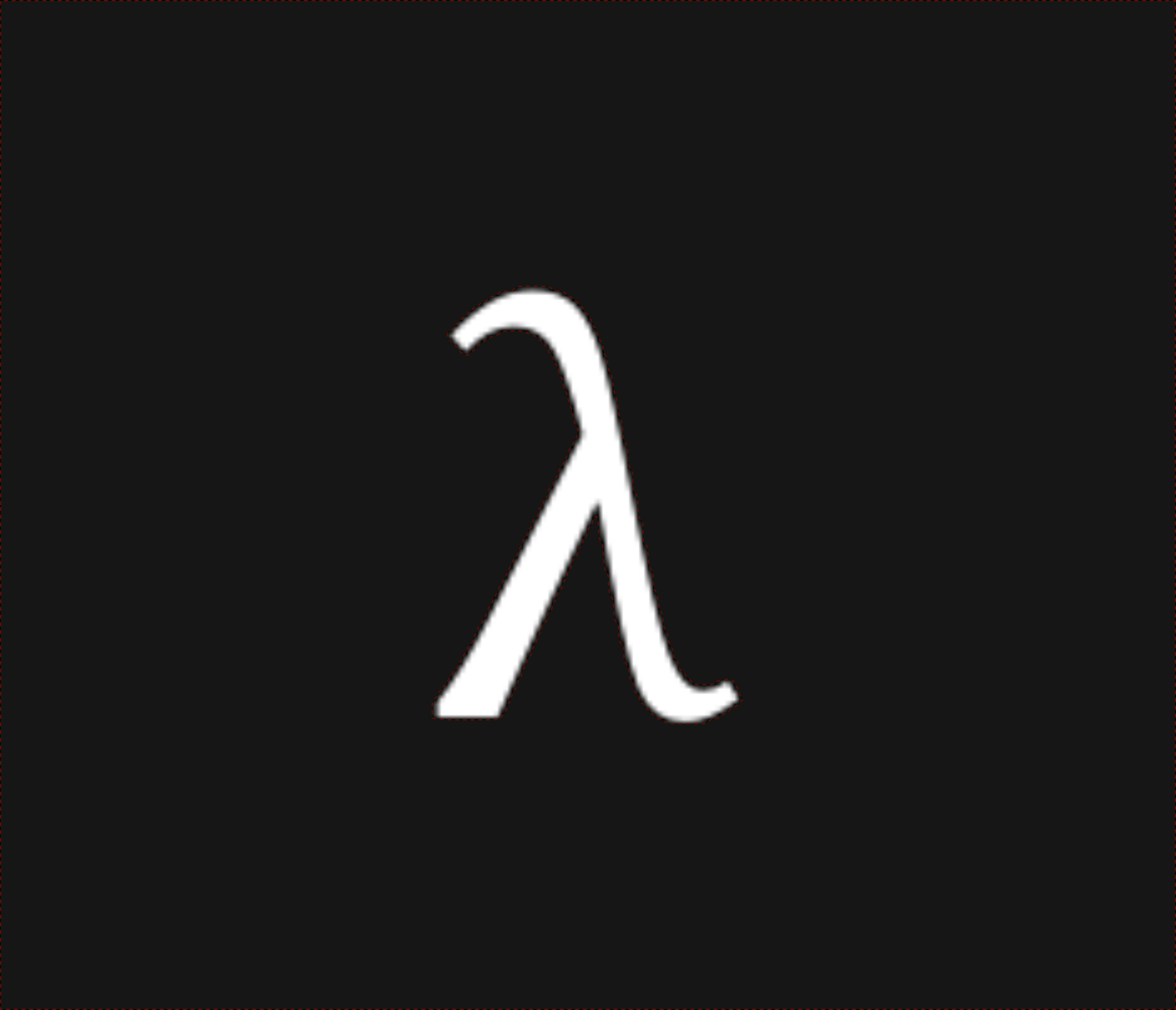
 nixpulvis
nixpulvis